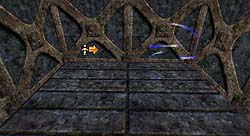| UED2 Tutorial - Teleporters |
Teleporters is used to transfer players instantly from one
place to another.

In the picture above you are able to see two teleporters.
The left one is a standard teleporter and will not be visible in the game.
The right one is a "Visible" teleporter and is for those who don't want to create
facy gfx or don't need the teleport to stay unseen.
The first teleporter is found under "NavigationPoint" in the actor browser, named "Teleporter".
Under the "Teleporter" you will find "VisibleTeleporter".
There is a few properties you can change:
|
| Property |
Specific |
| +Collision |
|
| CollisionHeight |
The area this teleporter will cover. |
| CollisionRadius |
The area this teleporter will cover. |
|
|
| +Events |
|
| Tag |
This is the name of this teleporter. |
|
|
| +Teleporter |
|
| bEnabled |
Enable/disable the teleporter for usage by players. |
| bChangesYAW |
Alter the direction the player face when teleporting. |
| bChangesVelocity |
Changes the moving speed of the player teleporting (destination). |
| URL |
This is the target destination teleporter (teleporter tag). |
|
|
|
Creating teleporters:
To create two working teleporters you must alter the correct properties for both.
First you must add a name/tag to each teleporter.
The first could be "tele1" and the second "tele2".
That is only the name. We also need to connect them.
In the teleporter named "tele1" you must add "tele2" to the "URL".
Vice versa for the second. "tele1" in "tele2"'s URL.
If the "URL" stays blank the teleporter will work as a destination only.
If more than one teleporter has the same name/tag players will arrive at a random one.
Changing players direction when teleporting:
To make sure that players face the correct direction when teleporting you must
enable "bChangesYAW" on both source and destiantion teleporters.
The source teleporter should face the direction you want players to enter from
(and the direction players face when this is the destination).
The destination teleporter should face the direction you want players to
face (and enter when it works as the source).
Confusing? Well, don't mind it too much until you have tested it a bit.
bEnabled vs URL:
Both options "bEnabled" and "URL" can be used to prevent players from using a
teleporter.
If you leave the "URL" blank the teleporter will not work for players at all.
It will work as a destination teleporter though, as long as another teleporter
has its "Tag" in the "URL".
The "bEnabled" (true or false) will also enable or disable the teleporter for
players. It will still be able to work as a destination teleporter.
If a trigger is connected with the teleporter the "bEnabled" will toggle between true
and false, giving a better control if the teleporter is supposed to allow players to
use it or no.
Teleporting to other levels:
Teleporting between two different maps is pretty much the same way two regular
teleporter works.
First of all you need two maps.
Each map should contain a teleporter so that you are able to actually get to
the destination teleporter.
The URL syntax you must use is "[mapname]#[teleporter]?peer".
'mapname' is the name of the map and 'teleporter' is the destination teleporter.
'peer' must be present as it tells the game to open a new map.
So in two maps called "castle.unr" and "gate.unr" you place one teleporter
in "castle.unr" and one in "gate.unr".
If the castle teleporter is called (event tag) "castle_tel" and the gate
teleporter (event tag) "gate_tel", the correct teleporter URL syntax to teleport from
gate.unr to castle.unr would be "castle.unr#castle_tel?peer".
|